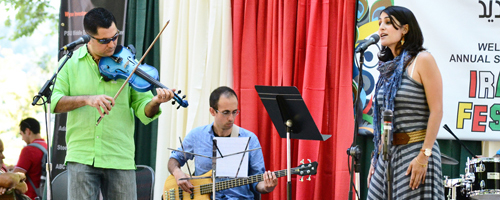Erik Sanchez is such an equipment geek that he freely admits he was told by fellow scientists at MIT, “I was ‘the worst they’d ever seen.’ I’m really into it, big.”
A singular passion
Erik Sanchez is such an equipment geek that he freely admits he was told by fellow scientists at MIT, “I was ‘the worst they’d ever seen.’ I’m really into it, big.”
Not only does Sanchez, an associate professor in physics, know how to work with high, high-tech science equipment in his nanotechnology development lab, he also knows how to design and repair them. That’s what he did to work his way through college.
It’s why Sachez believes, both scientifically and personally, that “anything is possible.” In science, however, he looks for empirical evidence. Of Cuban ancestry on his father’s side, Sanchez, 41, comes from a family of doctors, dentists and scientists. One aunt is the department head of physics at the University of Havana.
He likes to challenge his students by encouraging them to not only work with the equipment, but to also prepare for after college.
“Learn how to build good resumes. Some of them may want to go into industry after graduation,” he explained. “Some students think they can’t go to Harvard. If I could [he chose PSU instead], they can. It’s all attitude. My technique in class is to prepare them to be resourceful. I don’t spoon-feed information.”
Sanchez was in the honors program at Portland State and has worked at the Trojan Nuclear Plant as a systems engineer. For most of his adult life he has owned more equipment than most labs, because of operating his own company many years ago. He acquired, repaired and sold equipment.
His reputation spread throughout the scientific academic community as being able to build equipment from scratch and cheaply, and set up labs with the proper systems. While at Harvard he worked in three labs, including the Harvard chemistry department, Hanover and Woburn.
He established many contacts that led him to do business with many companies, including Tektronix, and helped assist them to liquidate assets.
His expertise led him to unusual opportunities for a student, such as becoming a consultant for NASA at their Space Vacuum Epitaxy Center in Houston, then later earning a doctorate after being a graduate student at the Environmental and Molecular Sciences Lab in connection to PSU.
Later he was a postdoctoral fellow, then research associate at Harvard, where he was invited to be a research professor before he left for PSU.
While at NASA, he assisted in a test crystal growing facility on a spacecraft that grew crystals in a pressure 10,000 times better in design than any previously created.
This would be an added motivation to offer reasons that could lead to a base on the moon. Recent data indicates that the moon has ice in the shadows of the craters at its poles. Water, hydrogen and oxygen could be extracted from the ice and allow travel for people to other planets, as well as asteroid detection or deterrent.
He and colleagues at the national lab (EMSL) built a microscope that has the best optical resolution in the world. It allows scientists to track a single molecule to better understand biology and is being completed at Portland State this year.
Over time he acquired enough science tools for his own labs. When he was invited to his present job at PSU in 2002, he brought 56,000 pounds of equipment worth as much as $2–3 million, which was trucked here in three semi-trucks. His donation of lab supplies is in line with his desire to help “good causes.”
“I want to prepare students for the next stage of their life,” he said.
Sanchez allows students and colleagues to use much of his equipment, and often gives equipment to students who are serious and want to build something related to learning and advancing knowledge.
He turned down a professorship at Harvard because, he said, “I was born at Good Sam[aritan] in 1967, and my mother is here and not well and my stepfather has cancer.” He prefers the West Coast.
Though Sanchez has science on his mind constantly, the man does have other interests, including Siberian huskies (he currently owns one but has owned many), software control, mineralogy, astronomy and thin film technology to name a few.
Sanchez’s dream is to reach or exceed the Heisenberg uncertainty principle, which gives a limit to how small one can visualize things. The microscope he developed has the best spatial optical resolution to date in imaging with fluorescence and Raman. For personally funded work, it is difficult to find new types of power sources, including those that are new concepts in physics.
All of this, and he still has time for a girlfriend.
For someone for whom work is so dominant in his life, it seems appropriate to ask how would he like to be remembered.
His answer says something about the man: “I would be happy just to be remembered, period.”



